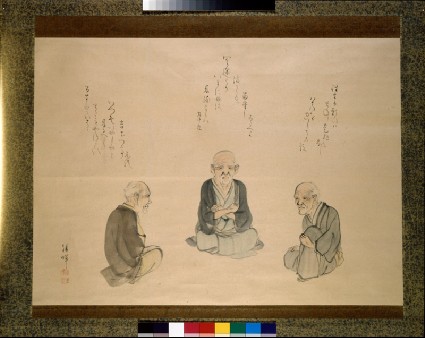Browse: 10610 objects
- Reference URL
Actions
Three old men thinking about death
-
Details
- Associated place
-
Asia › Japan › Honshū › Kyōto prefecture › Kyoto (possible place of creation)
- Date
- 1792 - 1864
- Artist/maker
-
Yokoyama Seiki (1792 - 1864) (artist)Yokoyama Seiki (1792 - 1864) (author)Maruyama-Shijō School (active late 18th century - late 19th century)
- Material and technique
- ink and colour on paper
- Dimensions
- 39.6 x 50.8 cm (height x width)
- Material index
- Technique index
- Object type index
- No. of items
- 1
- Credit line
- Purchased with the assistance of the Friends of the Ashmolean, and Mr and Mrs J. Hillier, 1973.
- Accession no.
- EA1973.191
-
Further reading
Katz, Janice, Japanese Paintings in the Ashmolean Museum, Oxford, with an introductory essay by Oliver Impey (Oxford: Ashmolean Museum, 2003), no. 32 on p. 122, p. 84, illus. p. 123
Location
-
- currently in research collection
Objects are sometimes moved to a different location. Our object location data is usually updated on a monthly basis. Contact the Jameel Study Centre if you are planning to visit the museum to see a particular object on display, or would like to arrange an appointment to see an object in our reserve collections.
Publications online
-

Japanese Paintings in the Ashmolean Museum
Three old men with stubborn expressions on their faces sit facing one another. Above them, the kyōka verses relate their thoughts:
Although death should bring comfort, this is not assured,
after one passes the age of eighty-eight.
If the messenger from the other world comes now,
I’ll answer that I’ll be out until I’m ninety-nine.
If you say you’re out, the messenger will certainly return.
Rather, I would just tell him to go away for good.
The verses, written in very colloquial, informal language speak of the messenger of the Buddha coming to take the men upon their death. Not convinced that a better place awaits them in the afterworld, they agree to defy death for as long as possible. Though they refute the Buddhist belief in salvation and rebirth, the trio sits in the form of a Buddhist triad. The figure in the middle takes the place of the Amida Buddha who ushers souls to the Pure Land after death. The two figures on either side mimic the Buddha's attendants. The direction in which the verses are read reinforces this allusion. The verse at the left reads right to left, the one on the right reads left to right, and the one in the middle is read beginning with the centre line first.
Yokoyama Seiki was a native of Kyoto and a pupil of Matsumura Keibun (1779-1843), himself a pupil of Goshun. He was a talented painter, and represented the Shijō school on important commissions such as decorating the Imperial Palace in 1855. It is tempting to see Three Old Men as a very telling composition, which gives us insight into Seiki's personality.
© 2013 University of Oxford - Ashmolean Museum

